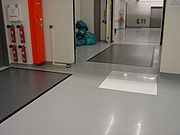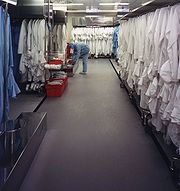
Contamination control
Encyclopedia
Contamination control is the generic term for all activities aiming to control the existence, growth and proliferation of contamination
in certain areas. Contamination control may refer to the atmosphere as well as to surfaces, to particulate matter as well as to microbes and to contamination prevention as well as to decontamination


. There are many preventative procedures in place within the cleanroom environment. Procedures include subjecting cleanroom staff to strict clothing regulations, and there is often a gowning room where the staff can change under sterile
conditions, so as to prevent any particulate from entering from the outside environment. Certain areas in the cleanroom have more stringent measures than others. Places such as packaging areas, corridors, gowning rooms and transfer hatches incorporate strict contamination control measures in order to keep to the cleanroom standards.
Contamination control is also an important asset to laboratories in industries such as the pharmaceutical and life science sectors. Other places of use include automotive paint shops, entrances to industrial kitchens and food service providers, many manufacturing areas, and in electronic component
assembly areas.
More recently contamination control has been a concern for laboratories and other sensitive environments as an effective bio-security crisis management
measure. Some bank
s and insurance
companies use contamination control products as part of their disaster management protocols. Preventative measures are put in place as preparation for potential pandemics or the proliferation of biohazard
s in any potential terrorist attack.
These, and many other damaging contaminants can infiltrate critical areas in a manner of ways. Particulate can enter by air, foot, or on any carrier between the external environment and inside the critical area.
s and other outcomes highly detrimental to businesses. A number of products over a range of industries are recalled due to ineffective contamination control systems.
By this evidence it could be argued that many businesses are not adequately protecting themselves from the harmful effects of contamination, and many products over many industries are being recalled due to unsafe manufacturing processes.
s and face mask
s are basic forms of contamination control. Apart from people, the other common way for contamination to enter is on the wheels of trolleys used to transport equipment.
To prevent airborne contamination, high efficiency particulate air (HEPA
) filters, airlocks and cleanroom suits are used. HEPA filtration systems used in the medical sector incorporate high-energy ultra-violet light units to kill off the live bacteria and viruses trapped by the filter media. These measures restrict the number of particulates within the atmosphere, and inhibit growth in those that are viable.
Studies by 3M show that over 80% of contamination enters the cleanroom through entrances and exits, mostly at or near floor level. To combat this suitable flooring systems are used that effectively attract, retain and inhibit growth of viable organisms. Studies show that the most effective type of flooring system is one of polymer composition.
Polymer mats are particularly effective due to their suppleness as they allow for more contact with serration on shoes and wheels and can accommodate for more particles whilst remaining effective. An electrostatic potential adds to the effectiveness of this type of contamination control as it holds particles until being cleaned. This method of attracting and retaining particles is more effective than mats with an active adhesive
coating which needs to be peeled and is often not as supple. As long as the tack level of the mat is greater than the donor (foot or wheel), the contamination touching the surface will be removed. Very high tack surfaces pose a contamination threat because they are prone to pulling off over-shoe protection.
Polymeric flooring is produced to ensure a higher level of tackiness than the surfaces it comes into contact with, without causing discomfort and potentially damaging ‘stickiness’.
Copper-alloy surfaces have natural intrinsic properties to effectively and quickly destroy microbes and are being installed in healthcare facilities and in a subway transit system as a protective public health measure in addition to regular cleanings. The United States Environmental Protection Agency
(EPA) has approved the registration of 355 different antibacterial copper alloys that kill E. coli O157:H7, methicillin
-resistant Staphylococcus aureus
(MRSA), Staphylococcus
, Enterobacter aerogenes, and Pseudomonas aeruginosa. The EPA has determined that when cleaned regularly, these copper alloy surfaces:
As a contamination control measure, EPA has approved a long list of antimicrobial copper products "with public health benefits" made from these copper alloys, such as bedrails, handrails, over-bed tables, sinks, faucets, door knobs, toilet
hardware, computer keyboards, health club
equipment, shopping cart
handles, etc. (for a comprehensive list of products, see: Antimicrobial copper-alloy touch surfaces#Approved products).
Contamination
Contamination is the presence of a minor and unwanted constituent in material, physical body, natural environment, at a workplace, etc.-Specifics:"Contamination" also has more specific meanings in science:...
in certain areas. Contamination control may refer to the atmosphere as well as to surfaces, to particulate matter as well as to microbes and to contamination prevention as well as to decontamination
Decontamination
Decontamination is the process of cleansing the human body to remove contamination by hazardous materials including chemicals, radioactive substances, and infectious material...


Function
The aim of all contamination control activities is to permanently ensure a sufficient level of cleanliness in controlled environments. This is accomplished by maintaining, reducing or eradicating viable and non-viable contamination for either sanitary purposes or in order to maintain an efficient rate of production.Usage
One of the most common environments that incorporates contamination control into its standards protocol is the cleanroomCleanroom
A cleanroom is an environment, typically used in manufacturing or scientific research, that has a low level of environmental pollutants such as dust, airborne microbes, aerosol particles and chemical vapors. More accurately, a cleanroom has a controlled level of contamination that is specified by...
. There are many preventative procedures in place within the cleanroom environment. Procedures include subjecting cleanroom staff to strict clothing regulations, and there is often a gowning room where the staff can change under sterile
Asepsis
Asepsis is the state of being free from disease-causing contaminants or, preventing contact with microorganisms. The term asepsis often refers to those practices used to promote or induce asepsis in an operative field in surgery or medicine to prevent infection...
conditions, so as to prevent any particulate from entering from the outside environment. Certain areas in the cleanroom have more stringent measures than others. Places such as packaging areas, corridors, gowning rooms and transfer hatches incorporate strict contamination control measures in order to keep to the cleanroom standards.
Contamination control is also an important asset to laboratories in industries such as the pharmaceutical and life science sectors. Other places of use include automotive paint shops, entrances to industrial kitchens and food service providers, many manufacturing areas, and in electronic component
Electronic component
An electronic component is a basic electronic element and may be available in a discrete form having two or more electrical terminals . These are intended to be connected together, usually by soldering to a printed circuit board, in order to create an electronic circuit with a particular function...
assembly areas.
More recently contamination control has been a concern for laboratories and other sensitive environments as an effective bio-security crisis management
Crisis management
Crisis management is the process by which an organization deals with a major event that threatens to harm the organization, its stakeholders, or the general public. The study of crisis management originated with the large scale industrial and environmental disasters in the 1980's.Shrivastava, P....
measure. Some bank
Bank
A bank is a financial institution that serves as a financial intermediary. The term "bank" may refer to one of several related types of entities:...
s and insurance
Insurance
In law and economics, insurance is a form of risk management primarily used to hedge against the risk of a contingent, uncertain loss. Insurance is defined as the equitable transfer of the risk of a loss, from one entity to another, in exchange for payment. An insurer is a company selling the...
companies use contamination control products as part of their disaster management protocols. Preventative measures are put in place as preparation for potential pandemics or the proliferation of biohazard
Biohazard
Biohazard may refer to:* Biological hazard* Biohazard , a book by Ken Alibek* Biohazard , a New York hardcore punk band** Biohazard , a self-titled album from Biohazard...
s in any potential terrorist attack.
Types of contamination
Beside of particulate matter, the most common type of contamination, ions and molecules (AMC) there are many types of organism that are potentially detrimental to processes in a critical environment. Seven of the most common contaminants are:- Aspergillus nigerAspergillus nigerAspergillus niger is a fungus and one of the most common species of the genus Aspergillus. It causes a disease called black mold on certain fruits and vegetables such as grapes, onions, and peanuts, and is a common contaminant of food...
- Burkholderia cepacia
- Clostridium difficileClostridium difficileClostridium difficile , also known as "CDF/cdf", or "C...
- Escherichia coliEscherichia coliEscherichia coli is a Gram-negative, rod-shaped bacterium that is commonly found in the lower intestine of warm-blooded organisms . Most E. coli strains are harmless, but some serotypes can cause serious food poisoning in humans, and are occasionally responsible for product recalls...
- Methicillin Resistant Staphylococcus aureus (MRSA)
- Pseudomonas aeruginosaPseudomonas aeruginosaPseudomonas aeruginosa is a common bacterium that can cause disease in animals, including humans. It is found in soil, water, skin flora, and most man-made environments throughout the world. It thrives not only in normal atmospheres, but also in hypoxic atmospheres, and has, thus, colonized many...
- Salmonella enteritidis
These, and many other damaging contaminants can infiltrate critical areas in a manner of ways. Particulate can enter by air, foot, or on any carrier between the external environment and inside the critical area.
The effects of contamination
Contamination poses a significant risk to technical processes of experiment or production as well as to the individual. Unguarded proliferation of contamination can quickly lead to product damage, yield reduction, product recallProduct recall
A product recall is a request to return to the maker a batch or an entire production run of a product, usually due to the discovery of safety issues. The recall is an effort to limit liability for corporate negligence and to improve or avoid damage to publicity...
s and other outcomes highly detrimental to businesses. A number of products over a range of industries are recalled due to ineffective contamination control systems.
By this evidence it could be argued that many businesses are not adequately protecting themselves from the harmful effects of contamination, and many products over many industries are being recalled due to unsafe manufacturing processes.
Types of contamination control
Body movement causes contamination and protective clothing such as hats, cleanroom suitCleanroom suit
A clean room suit, cleanroom suit, or bunny suit, is an overall garment worn in a clean room. One common type is an all-in-one coverall worn by semiconductor and nanotechnology line production workers, technicians, and process / equipment engineers, as well as people in similar roles creating...
s and face mask
Face mask
Strictly, the expression face mask is tautological and means "mask", because masks by definition go on the face; but it is sometimes used to mean:*Respirator*Among divers, diving mask...
s are basic forms of contamination control. Apart from people, the other common way for contamination to enter is on the wheels of trolleys used to transport equipment.
To prevent airborne contamination, high efficiency particulate air (HEPA
HEPA
High-Efficiency Particulate Air or HEPA is a type of air filter. Filters that are awarded the HEPA accolade are used in various locations, whether in medical facilities, automotive vehicles, airplanes, home filters, or wherever very pure air is sought. The filter must satisfy certain standards of...
) filters, airlocks and cleanroom suits are used. HEPA filtration systems used in the medical sector incorporate high-energy ultra-violet light units to kill off the live bacteria and viruses trapped by the filter media. These measures restrict the number of particulates within the atmosphere, and inhibit growth in those that are viable.
Studies by 3M show that over 80% of contamination enters the cleanroom through entrances and exits, mostly at or near floor level. To combat this suitable flooring systems are used that effectively attract, retain and inhibit growth of viable organisms. Studies show that the most effective type of flooring system is one of polymer composition.
Polymer mats are particularly effective due to their suppleness as they allow for more contact with serration on shoes and wheels and can accommodate for more particles whilst remaining effective. An electrostatic potential adds to the effectiveness of this type of contamination control as it holds particles until being cleaned. This method of attracting and retaining particles is more effective than mats with an active adhesive
Adhesive
An adhesive, or glue, is a mixture in a liquid or semi-liquid state that adheres or bonds items together. Adhesives may come from either natural or synthetic sources. The types of materials that can be bonded are vast but they are especially useful for bonding thin materials...
coating which needs to be peeled and is often not as supple. As long as the tack level of the mat is greater than the donor (foot or wheel), the contamination touching the surface will be removed. Very high tack surfaces pose a contamination threat because they are prone to pulling off over-shoe protection.
Polymeric flooring is produced to ensure a higher level of tackiness than the surfaces it comes into contact with, without causing discomfort and potentially damaging ‘stickiness’.
Copper-alloy surfaces have natural intrinsic properties to effectively and quickly destroy microbes and are being installed in healthcare facilities and in a subway transit system as a protective public health measure in addition to regular cleanings. The United States Environmental Protection Agency
United States Environmental Protection Agency
The U.S. Environmental Protection Agency is an agency of the federal government of the United States charged with protecting human health and the environment, by writing and enforcing regulations based on laws passed by Congress...
(EPA) has approved the registration of 355 different antibacterial copper alloys that kill E. coli O157:H7, methicillin
Methicillin
Meticillin or methicillin is a narrow-spectrum beta-lactam antibiotic of the penicillin class. It should not be confused with the antibiotic metacycline.-History:Methicillin was developed by Beecham in 1959...
-resistant Staphylococcus aureus
Staphylococcus aureus
Staphylococcus aureus is a facultative anaerobic Gram-positive coccal bacterium. It is frequently found as part of the normal skin flora on the skin and nasal passages. It is estimated that 20% of the human population are long-term carriers of S. aureus. S. aureus is the most common species of...
(MRSA), Staphylococcus
Staphylococcus
Staphylococcus is a genus of Gram-positive bacteria. Under the microscope they appear round , and form in grape-like clusters....
, Enterobacter aerogenes, and Pseudomonas aeruginosa. The EPA has determined that when cleaned regularly, these copper alloy surfaces:
- Continuously reduce bacterial contamination, achieving 99.9% reduction within two hours of exposure;
- Kill greater than 99.9% of Gram-negative and Gram-positive bacteria within two hours of exposure;
- Deliver continuous and ongoing antibacterial action, remaining effective in killing greater than 99.9% of bacteria within two hours;
- Kill greater than 99.9% of bacteria within two hours, and continue to kill 99% of bacteria even after repeated contamination;
- Help inhibit the buildup and growth of bacteria within two hours of exposure between routine cleaning and sanitizing steps.
As a contamination control measure, EPA has approved a long list of antimicrobial copper products "with public health benefits" made from these copper alloys, such as bedrails, handrails, over-bed tables, sinks, faucets, door knobs, toilet
Toilet
A toilet is a sanitation fixture used primarily for the disposal of human excrement, often found in a small room referred to as a toilet/bathroom/lavatory...
hardware, computer keyboards, health club
Health club
A health club is a place which houses exercise equipment for the purpose of physical exercise.-Main workout area:...
equipment, shopping cart
Shopping cart
A shopping cart is a cart supplied by a shop, especially supermarkets, for use by customers inside the shop for transport of merchandise to the check-out counter during shopping...
handles, etc. (for a comprehensive list of products, see: Antimicrobial copper-alloy touch surfaces#Approved products).

